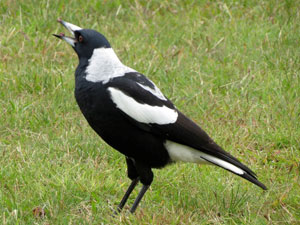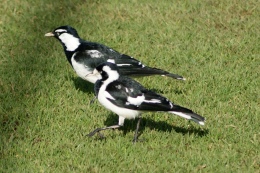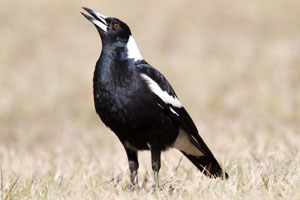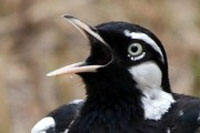Tom Parkinson's monthly column, introducing the diverse range of flora and fauna on show at Sanctuary Lakes.
Spring has started and Sanctuary Lakes’ fauna are out and about, mating, home building, burrowing, nesting and rearing new broods. We have two neighbours with very similar names who take mating, territory, nesting and broodings very seriously so much so that a small percentage of their males can become very aggressive to humans. They are the Magpies - Australian and Lark.
Confusion exists over the difference between Australian-Magpies and Magpie-Larks. Both species forage on the ground and are very commonly seen in Sanctuary Lakes Resort. Both walk rather than hop. They have similar colouration and common names, but they are not related in any way. The Magpie-Lark is from the family of monarch flycatchers (Monarchidae) and the Australian is classified in the butcherbird genus (Cracticus). Nor are either of them even vaguely related to the European Magpie.
 Australian Magpie But for all that, it is their size that is the most obvious difference.
Australian Magpie But for all that, it is their size that is the most obvious difference.
The Australian Magpie is around 40 to 45 cm tall and the Magpie Lark is about 10 cm smaller at 25 to 30 cm.
Colourisation is similar but the bills are black-tipped triangular for the Australian and an all-white bill for the Lark. The Australian’s breast is black whereas the Lark has a white breast with a black bib collar.
Eyes are a red-brown ring for the Australian and a white ring for the Lark. The Australian builds its nest out of branch sticks and the Lark from mud and grass.
 Magpie Lark Both feed on ground invertebrates such as earthworms, millipedes, snails, spiders and scorpions as well as a wide variety of insects — cockroaches, ants, beetles, moths and caterpillars and other larvae. The Australian due to its size is able to forage skinks, frogs, mice and other small animals, they are able to find scarab beetle larvae by sound or vibration. Both birds use their bills to probe into the earth or otherwise overturn debris in search of food. Due to their large and varied insect appetite both Magpies are the farmer’s friends.
Magpie Lark Both feed on ground invertebrates such as earthworms, millipedes, snails, spiders and scorpions as well as a wide variety of insects — cockroaches, ants, beetles, moths and caterpillars and other larvae. The Australian due to its size is able to forage skinks, frogs, mice and other small animals, they are able to find scarab beetle larvae by sound or vibration. Both birds use their bills to probe into the earth or otherwise overturn debris in search of food. Due to their large and varied insect appetite both Magpies are the farmer’s friends.
Strangely both Magies are highly-regarded songbirds and have common names which relate to the very distinctive sound of their singing. The “Flute” for the Australian Magie and the “Peewee” for the Lark.
 Australian or Flute Magpie in complex vocal dexterity The Aussie/Flute Magpie has an extraordinary wide variety of calls, many of which are complex, and their pitch may vary over and up to four octaves. They can mimic bird species, as well as other animal calls, such as dogs and horses.
Australian or Flute Magpie in complex vocal dexterity The Aussie/Flute Magpie has an extraordinary wide variety of calls, many of which are complex, and their pitch may vary over and up to four octaves. They can mimic bird species, as well as other animal calls, such as dogs and horses.
Pairs often take up complex Flute like call, known as carrolling, which they use to announce or defend their territory. Poet Denise Glover described the sound as “quardle oodle ardle wardle doodle”. Fledgling and juvenile magpies emit a repeated, short high-pitched begging call. When they feel threatened, magpies will also emit several high-pitched alarm calls.
 The Lark or Peewee Magpie enjoying a duet with its partner The Lark or Peewee are one of those rare bird species capable of singing in duet; each partner producing about one note a second, but a half-second apart, so that human ear finds it difficult to tell that there are actually two birds singing, not one. Each "peewee" phrase is accompanied by lifting and opening the wings, known as a "flag display".
The Lark or Peewee Magpie enjoying a duet with its partner The Lark or Peewee are one of those rare bird species capable of singing in duet; each partner producing about one note a second, but a half-second apart, so that human ear finds it difficult to tell that there are actually two birds singing, not one. Each "peewee" phrase is accompanied by lifting and opening the wings, known as a "flag display".
Magpie-Larks breed mainly as monogamous pairs with year-round pair bonds; most breeding is in late spring and summer. In Sanctuary Lakes their territories are close to the ponds where they are able to gather material for their characteristic mud-cup nest (also containing straw and rootlets) The nests are about 15 cm in diameter and attached to a horizontal branch or occasionally a manmade surface (the cross-beam of a power-pole). Both parents incubate the 3-4 pinkish eggs (28 x 21 mm), for about 18 days, followed by about 3 weeks of nurture. Dependent on the rainfall, multiple broods may be raised.
In slight contrast, the Australian-Magpies are found wherever there is a combination of trees and adjacent open areas, like the SL Golf Course and its surrounds. Small flocks of up to 8 to 10 birds live year round in distinct territories that are actively defended by all group members. The flock depends on their territory for its feeding, roosting and nesting requirements. The nest is a basic simple platform of sticks and twigs with a small interior bowl lined with grass and hair. The nest is constructed in the outer branches of a tree, up to 15 m above the ground. By mid-September, the Australian magpie will produce a clutch of two to five light blue or greenish eggs, which are oval in shape and about 30 by 40 mm in size. The chicks hatch around 20 days after incubation begins; nestlings are fed for around 20 days exclusively by the female, though the male magpie will feed his partner. The Australian-Magpie is known to engage in cooperative breeding, and helper birds from the territory flock will assist in feeding and raising young.
Both Magpies, Lark and Australian, are very protective of their territories during breeding. A small percentage (less than 10%) of male birds become highly aggressive as the eggs hatch. For the larger Australian Magpie, hatching is regularly between mid-September and early October. Larks can be variable depending on rainfall but eggs are normally incubating between late September and the end of November. But the moment eggs start hatching the small percentage of males of both magpies will start swooping and sometimes directly attack people who enter their territory. Generally both will attack pedestrians at around 50 m from their nest. Golfers with trundlers and cyclists at around 100 m. Attacks begin to increase in frequency and severity as the chicks grow, and tail off as the chicks leave the nest.
Obviously the simplest way of avoiding attack is not to enter the territories. Last year from most accounts the Australian Magpies were holding territory on the end of the 4th hole and the 5th on the Tournament Drive side, the 7th hole and the initial part of the 8th fairway. Both of these I have had personal experience of being swooped in the past couple of years. The 12th and 13th last year had an aggressive male, but due to the shrub removal between the fairways I think this could have changed this year. Also there was a bit of swooping in Signature Boulevard. The Magpie Lark although smaller can be as equally aggressive, their main territories are around most of the ponds and have been known to startle a couple on an early evening walk on the North Boulevard.
I can confirm from personal experience a swooping attack from either magpie is not a fun experience and it is important to take precautions if you are entering a known territory.
- Be diligent, look for the magpies, and listen for their distinctive calls. If you are swooped, please tell the Golf Club or the SLR Administration, so others can be warned.
- Keep calm. Avoid being aggressive. Walk quickly but do not run, keep your eye on the magpie and if on a bicycle dismount.
- If you are walking or with a golf trundler, carry an umbrella and open it up above your head in known territories. If you are with a trundler and have forgotten your umbrella, simply take out your driver place it across your shoulder with the large driver head some 30cm above your head. This double head like the umbrella confuses the Magpie where to attack.
- On very, very rare occasions the Magpie Lark can attack from the ground, aiming for the face and eyes. If you encounter a bird in this situation, cover and protect your eyes and move yourself calmly as possible out of the way. This is a real problem bird, again immediately tell the Club or the Admin.
Magpies, Australian and Lark, are highly intelligent and family-loving. Their birdsongs are uplifting, they are elegant and normally very friendly birds. Sure, swooping can be a bother for a short time each year but it is a small price to pay for ones who are essential in the natural control and balance that sustains a beautiful part of the Australian wildlife. Co-existing with magpies is easy to do. Remember, it is only a very small proportion of magpies who see humans as a threat and resort to swooping and even then, only within a very limited territorial area.